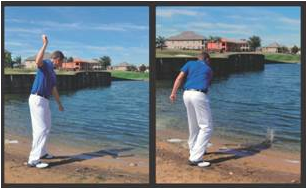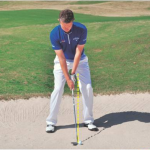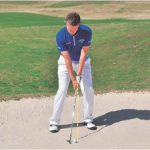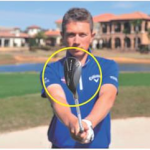Basic Bunker Shots
Basic bunker shot technique
Bunkers are a hazard that many amateurs are scared of more than any other hazard. Just one bunker can turn a good round into a bad round! The problem is a fundamental problem in the way bunkers shots are taught – especially in articles. Most of the time, with anything to do with golf instruction, keeping it as simple as possible is a good thing. However, when instructions try to over-simplify bunker play, improvement cannot be made. Bunker play is not simple. Each shot you will face can be of a different length, different height, and with different sand conditions (hard/soft/wet/dry), which means there can be no STANDARD bunker technique. One technique might work very well in a situation with the right sand, length and height of shot, but the same technique in a different bunker with different conditions might not even get the ball out of the bunker!
What I want to show you is how you need to change your technique to match the situation. There are a few more things to understand than simply learning a standard technique, but the information will give you an opportunity to improve.
Sand Condition
To be a good bunker player, which means you can play good bunker shots from any sand condition, you must understand how the bounce works on your sand wedge. The bounce works much like a smooth stone skipping across water. The softer the sand, the more bounce you need. The harder the sand, the less bounce you need.
How to increase bounce
Ball position to the left – The more the ball is positioned to the left of the centre of your stance, the more the bounce will increase. It is important to note that this will place the club head in front of your hands, with the shaft angled away from target.
Club face – By rotating the club face open before taking your grip, the bounce will also increase.
Swing – A flatter swing (in – to – out) will increase the bounce at impact. It would be the same as keeping your throwing hand close to the ground when skipping the stone on the water.
How much you change these will depend upon how soft the sand is. The picture shows a good example of a set up for an extremely soft sand condition.
How to decrease bounce:
Ball position to the right – The more the ball is positioned to the right, the more the bounce will decrease. This will place your hands in front of the club head with the club shaft angled forward.
 Club face closed – By rotating the clubface closed before taking your grip, the bounce will decrease.
Club face closed – By rotating the clubface closed before taking your grip, the bounce will decrease.
Swing – A more up & down swing (out – to – in) will decrease the bounce at impact. It would be the same as throwing the stone into the water, lifting your arm up high in the backswing.
How much you change these will depend upon how hard the sand is. The picture shows a good example of a set up for an extremely hard sand condition.
If you understand how to change the bounce of the club in different sand conditions, you will always be able to get out of a bunker; therefore, this is the first thing you should learn. The next article will focus on advanced bunker shots; this is when you want to start thinking about getting close!





